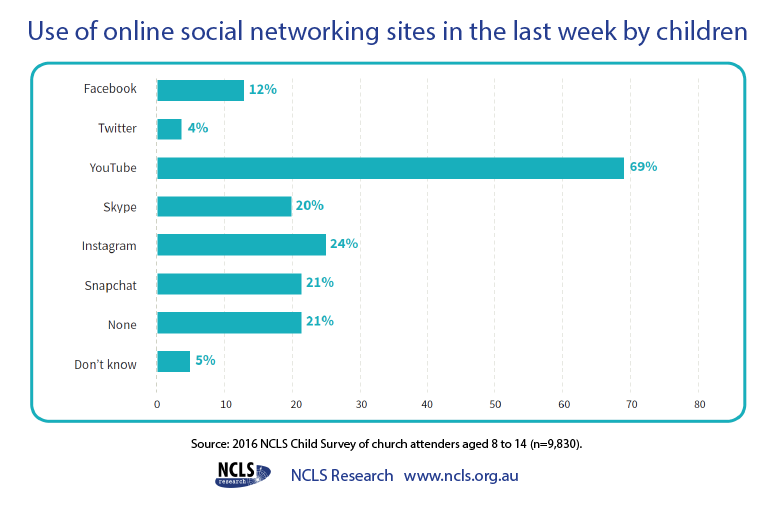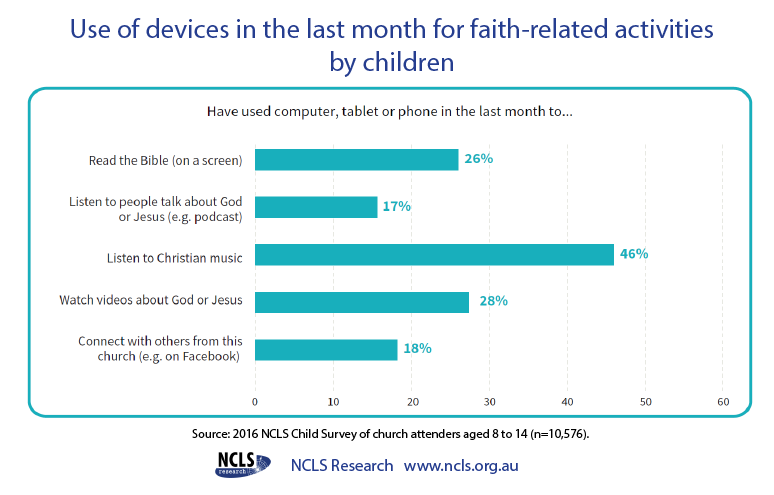Relationships rely on good communication. One of the challenges and opportunities of our contemporary society is that technology is intrinsic in communication.
The 2016 NCLS asked young churchgoers aged 8 to 14 about their use of technology. We investigated children’s access to mobile phones; which social networking sites are most popular; and the use of devices for faith-related activities. Results show the importance of digital devices for activities related to faith. Just under half of children have used devices to listen to Christian music, and around one-quarter have used them to watch videos about God or Jesus, or read the Bible on a screen.
Mobile phones are common
Young people today are growing up with a seamless integration of technology in their lives. In the 2016 NCLS we investigated that presence of technology and its use in the lives of child attenders. For instance, we asked children: do you have your own mobile phone; which social networking sites have you used in the last week; and have you used your computer, tablet or phone, to do any faith-related activities in the last month?
Results from over 10,000 children surveyed show that around half of child attenders aged 8 to 14 (48%) have access to a mobile phone.
As mobile phones have connection to the internet, as well as cameras, videos and voice recorders, it can be assumed that potential use of the phone goes beyond calling or texting others, to surfing the internet, looking up websites, taking and sharing photos and videos, and using voice activated applications.
YouTube tops the list for social networking
As technological and social trends change rapidly, the popularity of websites and emergence of new ones is changeable. But in 2016 the most commonly used site was YouTube by nearly seven in ten children (69%). Only 21% had not used any social networking sites.

Music and videos are most common online faith activities
Results show the importance of digital devices for activities related to faith. Just under half (46%) of children use a device to listen to Christian music, and over a quarter use it to watch videos about God or Jesus (28%), or read the Bible on a screen (26%). Just below two in 10 children listen to audio and connect with others from the church via digital devices.

For all the differing views on the benefits and risks that accompany the realms of social media there appears top be positive trends in its use by churchgoing children. Forty-six percent use the medium to listen to Christian music. Hence, children surveyed are indeed using it to build their faith. Although, connecting with others from church via digital devices is less prominent.
Connecting online during times of social distancing
Given the years since the 2016 NCLS, with the global pandemic and the COVID-19 social-distancing restrictions, technology has come to the fore in many aspects of life for children including schooling and church activities. It will be valuable to see if child church attenders’ use of technology in engaging with and practicing their faith has changed in that context. As churches navigate the new normal of social restrictions, and moving to hybrid or online models of gathering, understanding how to connect with their young churchgoers is of importance, including online or at-home practices.
Does the local church need to get aboard the social-media juggernaut with more gusto if it is to remain relevant and connected with young people? Does it need to be more proactive in sharing this space with many other organisations? Can churches support families as they school from home, work from home and church from home with increasing frequency in these circumstances?
Kathy Jacka and Ruth Powell, NCLS Research with Rod Bennett, WildHive Studios.
Faith formation in children at church and home
Beliefs, identity and faith practices of child churchgoers
How do children feel about their church activities?
Children's evaluation of activities and worship services
Helping child churchgoers use their gifts and skills
Building capacity for mission and empowering children at church
How do child churchgoers rate their wellbeing?
Children rate their happiness in a number of areas of their life








